Policy Approaches to Tourism Destination Planning & Development
VerifiedAdded on 2023/01/18
|12
|2646
|28
Report
AI Summary
This report provides an executive summary of tourism destination planning and development, focusing on the Great Lakes region. It examines policy approaches to managing and regenerating tourism destinations, including environmental planning, community-based tourism, stakeholder engagement, and economic considerations. The report further explores holistic tourism planning for sustainable development, emphasizing planning at national, regional, and local levels, stakeholder involvement, and addressing triple sustainability issues (economic, social, and environmental). Finally, it details the role of tourism planning in developing and regenerating destinations, highlighting social, environmental, and economic benefits such as poverty reduction, cultural promotion, cleanliness, resource management, and job creation. The report aims to provide a comprehensive overview of effective tourism strategies.
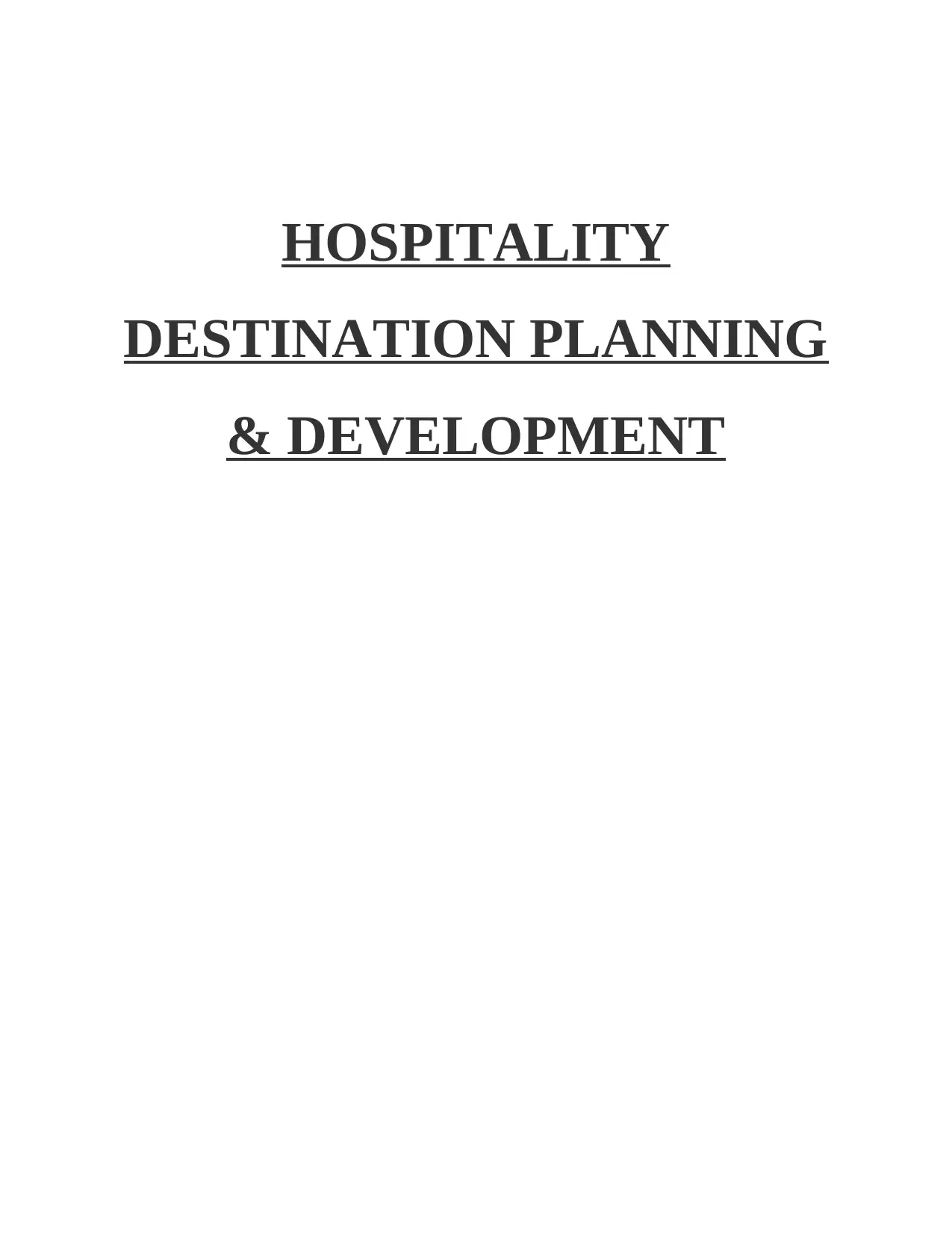
HOSPITALITY
DESTINATION PLANNING
& DEVELOPMENT
DESTINATION PLANNING
& DEVELOPMENT
Paraphrase This Document
Need a fresh take? Get an instant paraphrase of this document with our AI Paraphraser
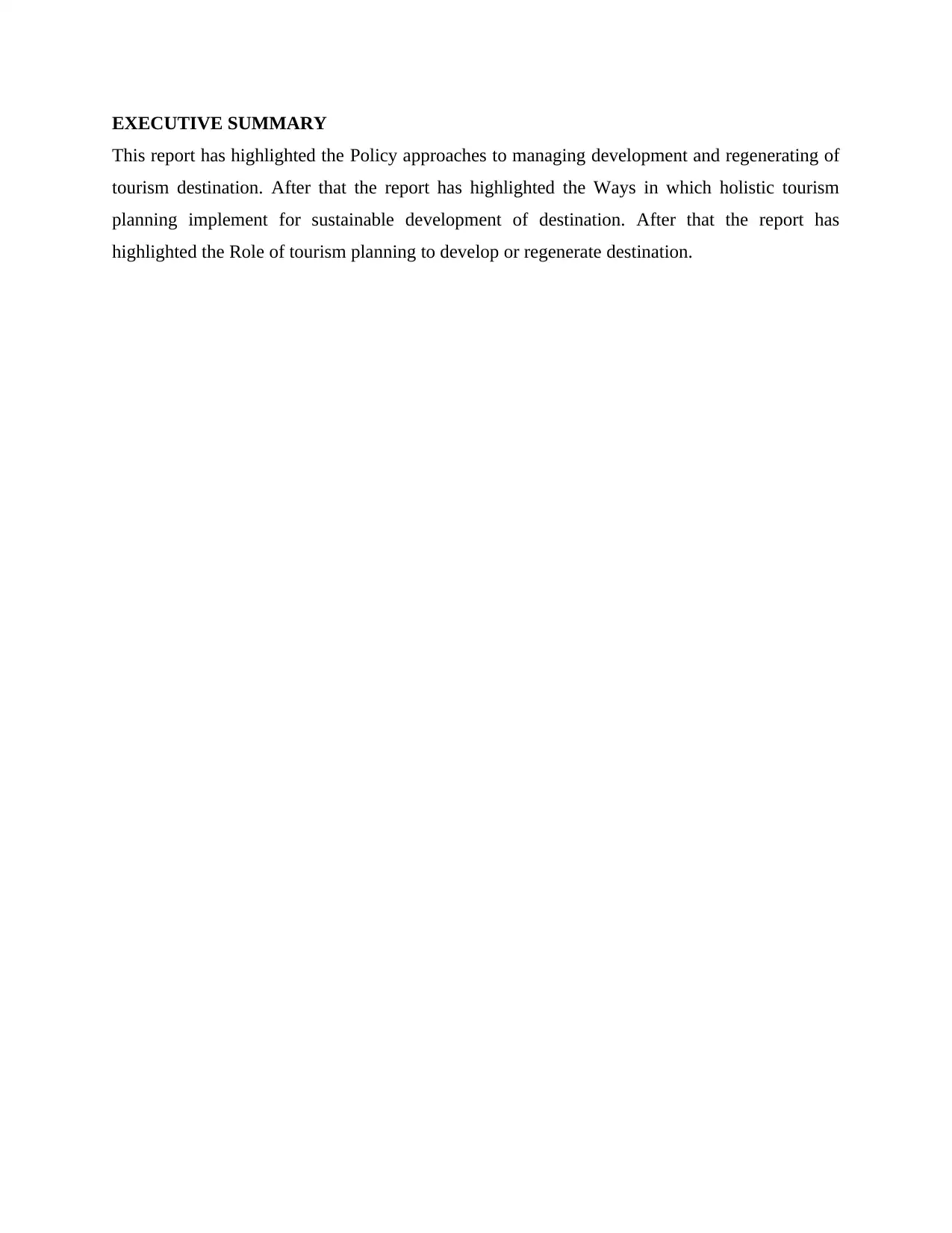
EXECUTIVE SUMMARY
This report has highlighted the Policy approaches to managing development and regenerating of
tourism destination. After that the report has highlighted the Ways in which holistic tourism
planning implement for sustainable development of destination. After that the report has
highlighted the Role of tourism planning to develop or regenerate destination.
This report has highlighted the Policy approaches to managing development and regenerating of
tourism destination. After that the report has highlighted the Ways in which holistic tourism
planning implement for sustainable development of destination. After that the report has
highlighted the Role of tourism planning to develop or regenerate destination.
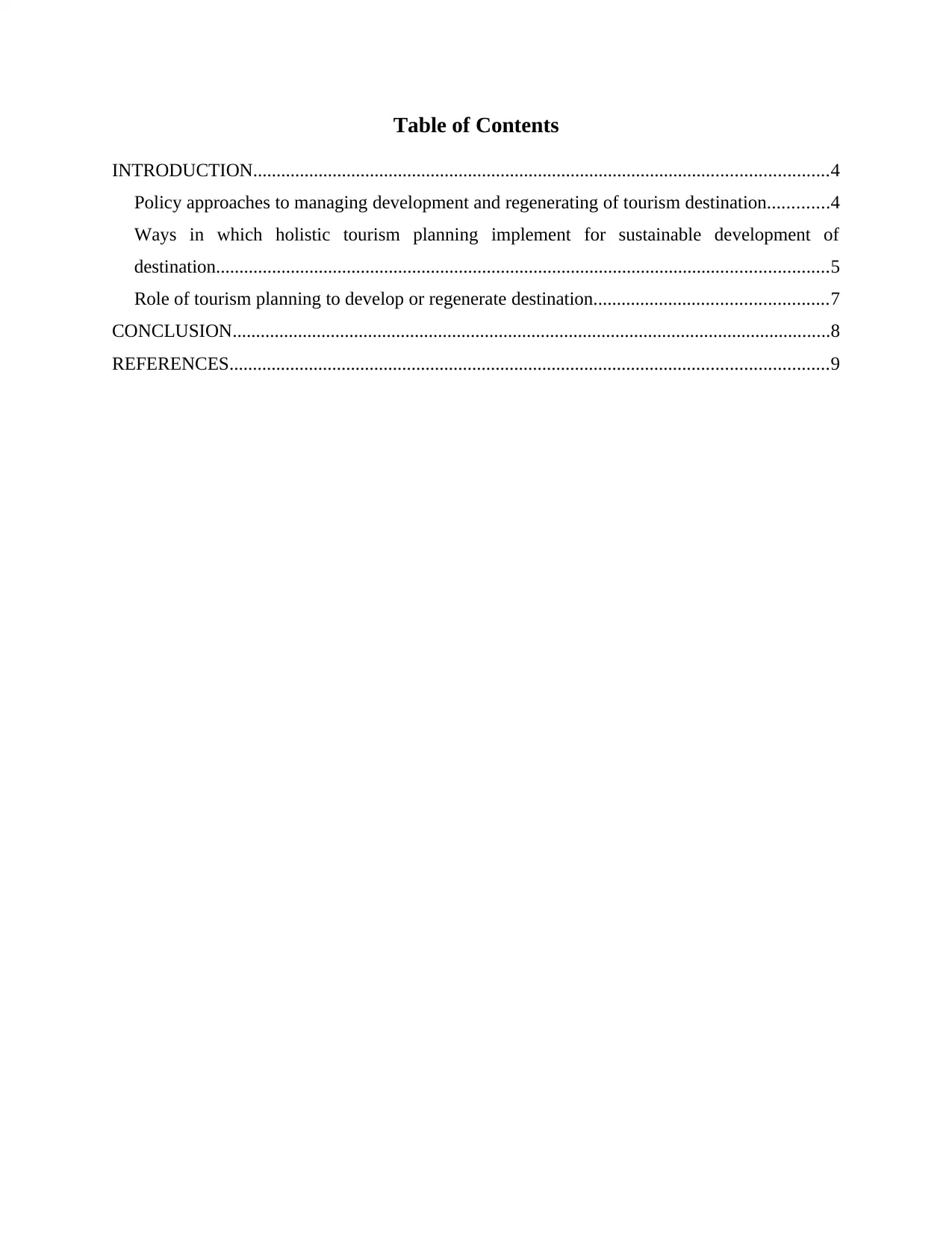
Table of Contents
INTRODUCTION...........................................................................................................................4
Policy approaches to managing development and regenerating of tourism destination.............4
Ways in which holistic tourism planning implement for sustainable development of
destination...................................................................................................................................5
Role of tourism planning to develop or regenerate destination..................................................7
CONCLUSION................................................................................................................................8
REFERENCES................................................................................................................................9
INTRODUCTION...........................................................................................................................4
Policy approaches to managing development and regenerating of tourism destination.............4
Ways in which holistic tourism planning implement for sustainable development of
destination...................................................................................................................................5
Role of tourism planning to develop or regenerate destination..................................................7
CONCLUSION................................................................................................................................8
REFERENCES................................................................................................................................9
⊘ This is a preview!⊘
Do you want full access?
Subscribe today to unlock all pages.

Trusted by 1+ million students worldwide
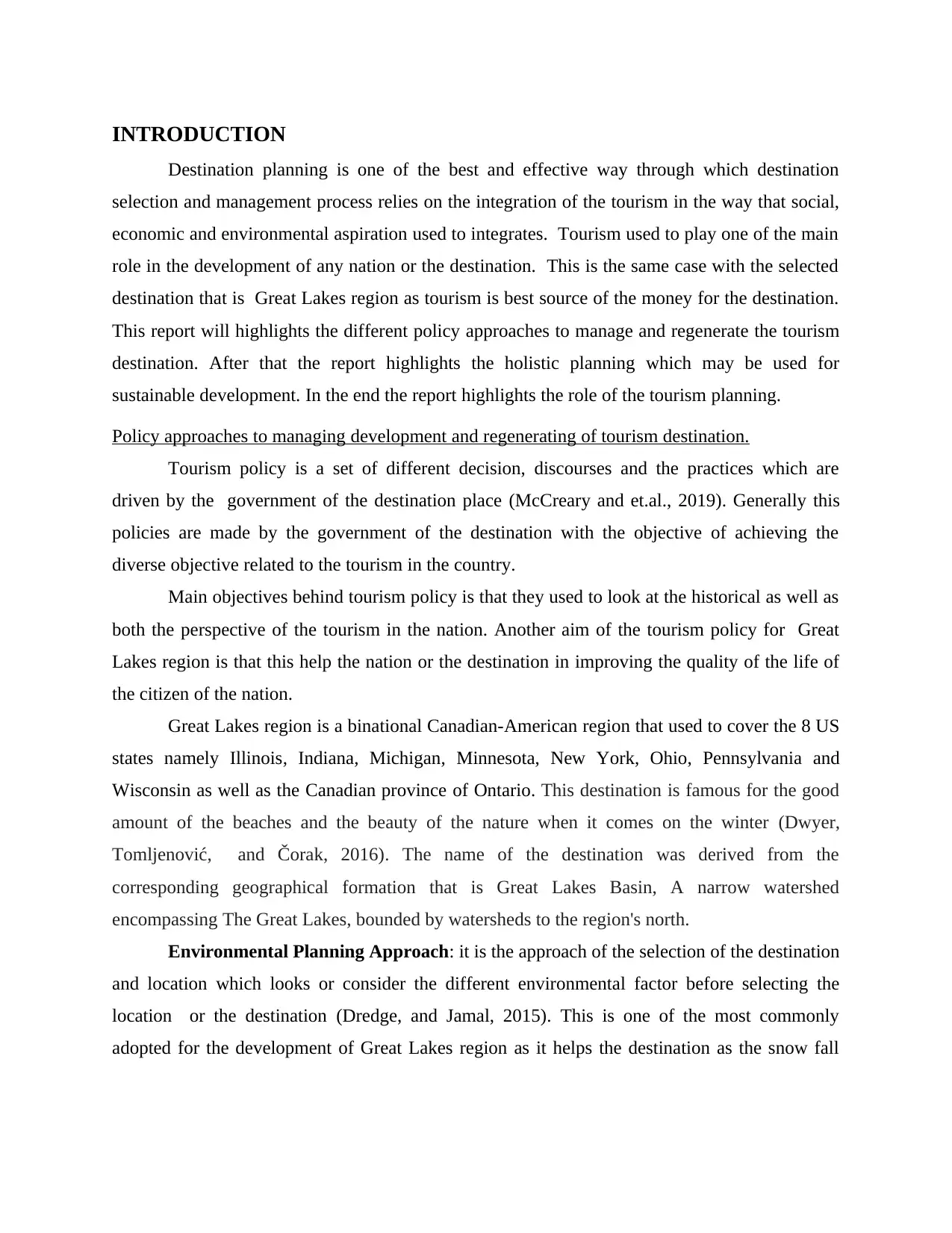
INTRODUCTION
Destination planning is one of the best and effective way through which destination
selection and management process relies on the integration of the tourism in the way that social,
economic and environmental aspiration used to integrates. Tourism used to play one of the main
role in the development of any nation or the destination. This is the same case with the selected
destination that is Great Lakes region as tourism is best source of the money for the destination.
This report will highlights the different policy approaches to manage and regenerate the tourism
destination. After that the report highlights the holistic planning which may be used for
sustainable development. In the end the report highlights the role of the tourism planning.
Policy approaches to managing development and regenerating of tourism destination.
Tourism policy is a set of different decision, discourses and the practices which are
driven by the government of the destination place (McCreary and et.al., 2019). Generally this
policies are made by the government of the destination with the objective of achieving the
diverse objective related to the tourism in the country.
Main objectives behind tourism policy is that they used to look at the historical as well as
both the perspective of the tourism in the nation. Another aim of the tourism policy for Great
Lakes region is that this help the nation or the destination in improving the quality of the life of
the citizen of the nation.
Great Lakes region is a binational Canadian-American region that used to cover the 8 US
states namely Illinois, Indiana, Michigan, Minnesota, New York, Ohio, Pennsylvania and
Wisconsin as well as the Canadian province of Ontario. This destination is famous for the good
amount of the beaches and the beauty of the nature when it comes on the winter (Dwyer,
Tomljenović, and Čorak, 2016). The name of the destination was derived from the
corresponding geographical formation that is Great Lakes Basin, A narrow watershed
encompassing The Great Lakes, bounded by watersheds to the region's north.
Environmental Planning Approach: it is the approach of the selection of the destination
and location which looks or consider the different environmental factor before selecting the
location or the destination (Dredge, and Jamal, 2015). This is one of the most commonly
adopted for the development of Great Lakes region as it helps the destination as the snow fall
Destination planning is one of the best and effective way through which destination
selection and management process relies on the integration of the tourism in the way that social,
economic and environmental aspiration used to integrates. Tourism used to play one of the main
role in the development of any nation or the destination. This is the same case with the selected
destination that is Great Lakes region as tourism is best source of the money for the destination.
This report will highlights the different policy approaches to manage and regenerate the tourism
destination. After that the report highlights the holistic planning which may be used for
sustainable development. In the end the report highlights the role of the tourism planning.
Policy approaches to managing development and regenerating of tourism destination.
Tourism policy is a set of different decision, discourses and the practices which are
driven by the government of the destination place (McCreary and et.al., 2019). Generally this
policies are made by the government of the destination with the objective of achieving the
diverse objective related to the tourism in the country.
Main objectives behind tourism policy is that they used to look at the historical as well as
both the perspective of the tourism in the nation. Another aim of the tourism policy for Great
Lakes region is that this help the nation or the destination in improving the quality of the life of
the citizen of the nation.
Great Lakes region is a binational Canadian-American region that used to cover the 8 US
states namely Illinois, Indiana, Michigan, Minnesota, New York, Ohio, Pennsylvania and
Wisconsin as well as the Canadian province of Ontario. This destination is famous for the good
amount of the beaches and the beauty of the nature when it comes on the winter (Dwyer,
Tomljenović, and Čorak, 2016). The name of the destination was derived from the
corresponding geographical formation that is Great Lakes Basin, A narrow watershed
encompassing The Great Lakes, bounded by watersheds to the region's north.
Environmental Planning Approach: it is the approach of the selection of the destination
and location which looks or consider the different environmental factor before selecting the
location or the destination (Dredge, and Jamal, 2015). This is one of the most commonly
adopted for the development of Great Lakes region as it helps the destination as the snow fall
Paraphrase This Document
Need a fresh take? Get an instant paraphrase of this document with our AI Paraphraser
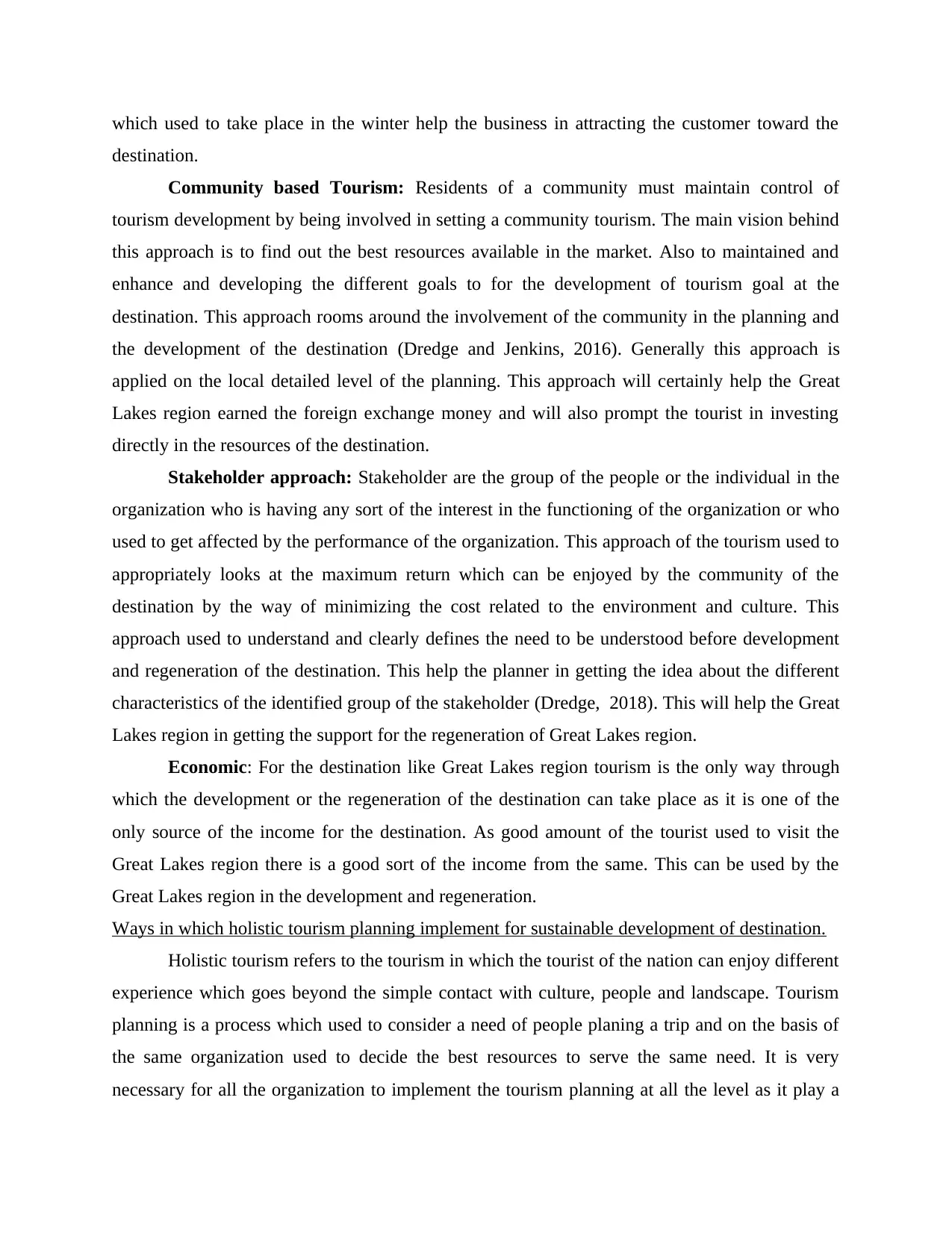
which used to take place in the winter help the business in attracting the customer toward the
destination.
Community based Tourism: Residents of a community must maintain control of
tourism development by being involved in setting a community tourism. The main vision behind
this approach is to find out the best resources available in the market. Also to maintained and
enhance and developing the different goals to for the development of tourism goal at the
destination. This approach rooms around the involvement of the community in the planning and
the development of the destination (Dredge and Jenkins, 2016). Generally this approach is
applied on the local detailed level of the planning. This approach will certainly help the Great
Lakes region earned the foreign exchange money and will also prompt the tourist in investing
directly in the resources of the destination.
Stakeholder approach: Stakeholder are the group of the people or the individual in the
organization who is having any sort of the interest in the functioning of the organization or who
used to get affected by the performance of the organization. This approach of the tourism used to
appropriately looks at the maximum return which can be enjoyed by the community of the
destination by the way of minimizing the cost related to the environment and culture. This
approach used to understand and clearly defines the need to be understood before development
and regeneration of the destination. This help the planner in getting the idea about the different
characteristics of the identified group of the stakeholder (Dredge, 2018). This will help the Great
Lakes region in getting the support for the regeneration of Great Lakes region.
Economic: For the destination like Great Lakes region tourism is the only way through
which the development or the regeneration of the destination can take place as it is one of the
only source of the income for the destination. As good amount of the tourist used to visit the
Great Lakes region there is a good sort of the income from the same. This can be used by the
Great Lakes region in the development and regeneration.
Ways in which holistic tourism planning implement for sustainable development of destination.
Holistic tourism refers to the tourism in which the tourist of the nation can enjoy different
experience which goes beyond the simple contact with culture, people and landscape. Tourism
planning is a process which used to consider a need of people planing a trip and on the basis of
the same organization used to decide the best resources to serve the same need. It is very
necessary for all the organization to implement the tourism planning at all the level as it play a
destination.
Community based Tourism: Residents of a community must maintain control of
tourism development by being involved in setting a community tourism. The main vision behind
this approach is to find out the best resources available in the market. Also to maintained and
enhance and developing the different goals to for the development of tourism goal at the
destination. This approach rooms around the involvement of the community in the planning and
the development of the destination (Dredge and Jenkins, 2016). Generally this approach is
applied on the local detailed level of the planning. This approach will certainly help the Great
Lakes region earned the foreign exchange money and will also prompt the tourist in investing
directly in the resources of the destination.
Stakeholder approach: Stakeholder are the group of the people or the individual in the
organization who is having any sort of the interest in the functioning of the organization or who
used to get affected by the performance of the organization. This approach of the tourism used to
appropriately looks at the maximum return which can be enjoyed by the community of the
destination by the way of minimizing the cost related to the environment and culture. This
approach used to understand and clearly defines the need to be understood before development
and regeneration of the destination. This help the planner in getting the idea about the different
characteristics of the identified group of the stakeholder (Dredge, 2018). This will help the Great
Lakes region in getting the support for the regeneration of Great Lakes region.
Economic: For the destination like Great Lakes region tourism is the only way through
which the development or the regeneration of the destination can take place as it is one of the
only source of the income for the destination. As good amount of the tourist used to visit the
Great Lakes region there is a good sort of the income from the same. This can be used by the
Great Lakes region in the development and regeneration.
Ways in which holistic tourism planning implement for sustainable development of destination.
Holistic tourism refers to the tourism in which the tourist of the nation can enjoy different
experience which goes beyond the simple contact with culture, people and landscape. Tourism
planning is a process which used to consider a need of people planing a trip and on the basis of
the same organization used to decide the best resources to serve the same need. It is very
necessary for all the organization to implement the tourism planning at all the level as it play a
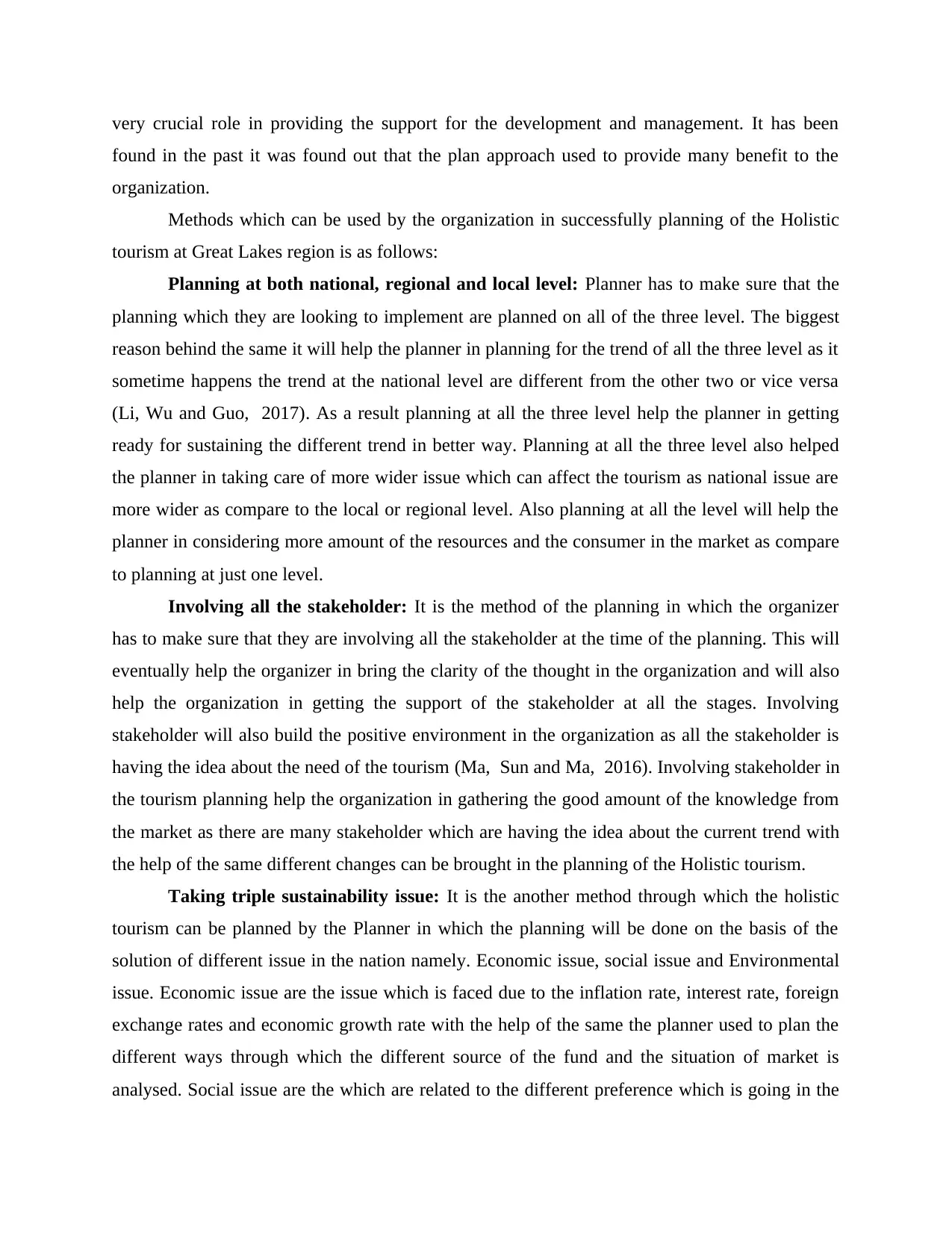
very crucial role in providing the support for the development and management. It has been
found in the past it was found out that the plan approach used to provide many benefit to the
organization.
Methods which can be used by the organization in successfully planning of the Holistic
tourism at Great Lakes region is as follows:
Planning at both national, regional and local level: Planner has to make sure that the
planning which they are looking to implement are planned on all of the three level. The biggest
reason behind the same it will help the planner in planning for the trend of all the three level as it
sometime happens the trend at the national level are different from the other two or vice versa
(Li, Wu and Guo, 2017). As a result planning at all the three level help the planner in getting
ready for sustaining the different trend in better way. Planning at all the three level also helped
the planner in taking care of more wider issue which can affect the tourism as national issue are
more wider as compare to the local or regional level. Also planning at all the level will help the
planner in considering more amount of the resources and the consumer in the market as compare
to planning at just one level.
Involving all the stakeholder: It is the method of the planning in which the organizer
has to make sure that they are involving all the stakeholder at the time of the planning. This will
eventually help the organizer in bring the clarity of the thought in the organization and will also
help the organization in getting the support of the stakeholder at all the stages. Involving
stakeholder will also build the positive environment in the organization as all the stakeholder is
having the idea about the need of the tourism (Ma, Sun and Ma, 2016). Involving stakeholder in
the tourism planning help the organization in gathering the good amount of the knowledge from
the market as there are many stakeholder which are having the idea about the current trend with
the help of the same different changes can be brought in the planning of the Holistic tourism.
Taking triple sustainability issue: It is the another method through which the holistic
tourism can be planned by the Planner in which the planning will be done on the basis of the
solution of different issue in the nation namely. Economic issue, social issue and Environmental
issue. Economic issue are the issue which is faced due to the inflation rate, interest rate, foreign
exchange rates and economic growth rate with the help of the same the planner used to plan the
different ways through which the different source of the fund and the situation of market is
analysed. Social issue are the which are related to the different preference which is going in the
found in the past it was found out that the plan approach used to provide many benefit to the
organization.
Methods which can be used by the organization in successfully planning of the Holistic
tourism at Great Lakes region is as follows:
Planning at both national, regional and local level: Planner has to make sure that the
planning which they are looking to implement are planned on all of the three level. The biggest
reason behind the same it will help the planner in planning for the trend of all the three level as it
sometime happens the trend at the national level are different from the other two or vice versa
(Li, Wu and Guo, 2017). As a result planning at all the three level help the planner in getting
ready for sustaining the different trend in better way. Planning at all the three level also helped
the planner in taking care of more wider issue which can affect the tourism as national issue are
more wider as compare to the local or regional level. Also planning at all the level will help the
planner in considering more amount of the resources and the consumer in the market as compare
to planning at just one level.
Involving all the stakeholder: It is the method of the planning in which the organizer
has to make sure that they are involving all the stakeholder at the time of the planning. This will
eventually help the organizer in bring the clarity of the thought in the organization and will also
help the organization in getting the support of the stakeholder at all the stages. Involving
stakeholder will also build the positive environment in the organization as all the stakeholder is
having the idea about the need of the tourism (Ma, Sun and Ma, 2016). Involving stakeholder in
the tourism planning help the organization in gathering the good amount of the knowledge from
the market as there are many stakeholder which are having the idea about the current trend with
the help of the same different changes can be brought in the planning of the Holistic tourism.
Taking triple sustainability issue: It is the another method through which the holistic
tourism can be planned by the Planner in which the planning will be done on the basis of the
solution of different issue in the nation namely. Economic issue, social issue and Environmental
issue. Economic issue are the issue which is faced due to the inflation rate, interest rate, foreign
exchange rates and economic growth rate with the help of the same the planner used to plan the
different ways through which the different source of the fund and the situation of market is
analysed. Social issue are the which are related to the different preference which is going in the
⊘ This is a preview!⊘
Do you want full access?
Subscribe today to unlock all pages.

Trusted by 1+ million students worldwide
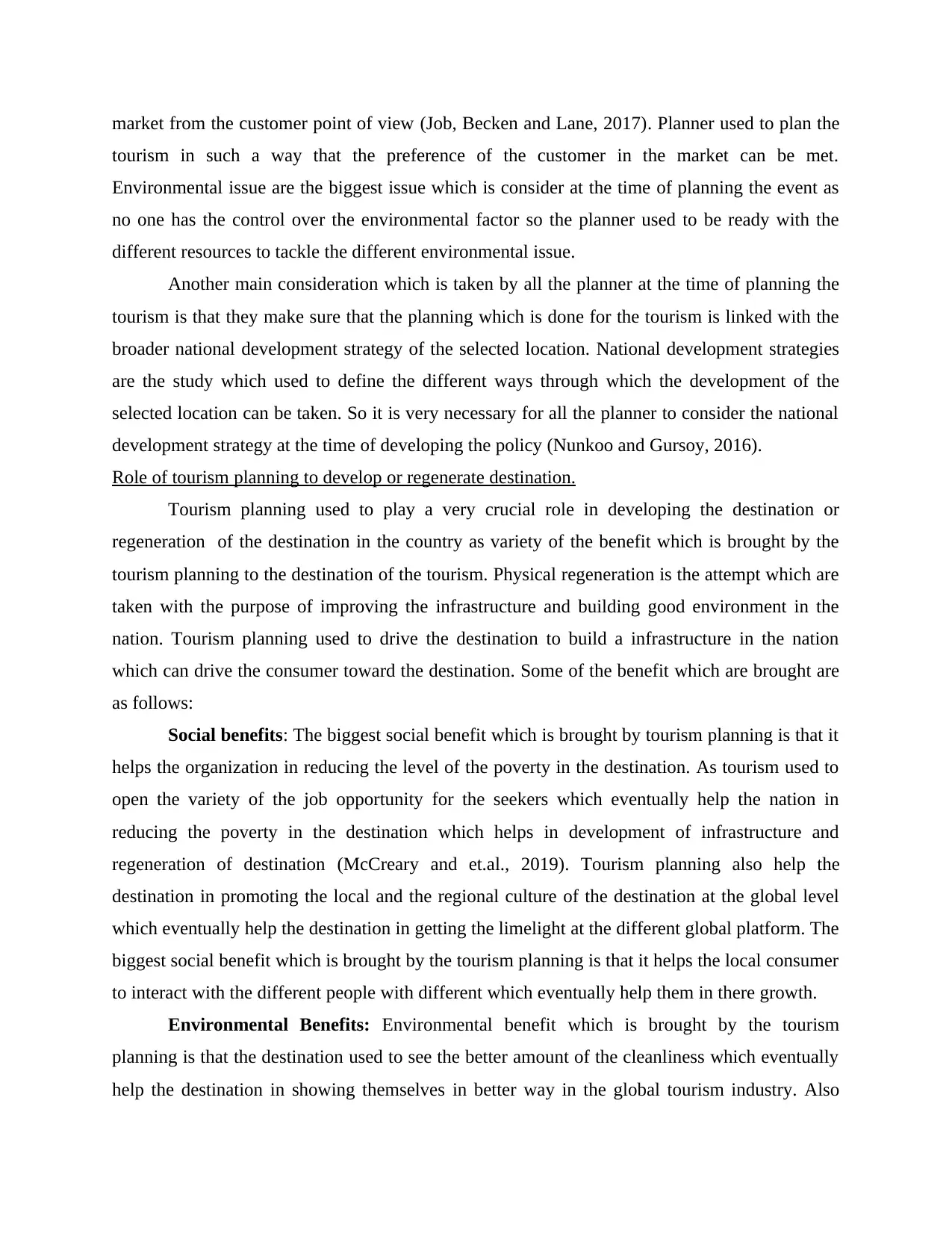
market from the customer point of view (Job, Becken and Lane, 2017). Planner used to plan the
tourism in such a way that the preference of the customer in the market can be met.
Environmental issue are the biggest issue which is consider at the time of planning the event as
no one has the control over the environmental factor so the planner used to be ready with the
different resources to tackle the different environmental issue.
Another main consideration which is taken by all the planner at the time of planning the
tourism is that they make sure that the planning which is done for the tourism is linked with the
broader national development strategy of the selected location. National development strategies
are the study which used to define the different ways through which the development of the
selected location can be taken. So it is very necessary for all the planner to consider the national
development strategy at the time of developing the policy (Nunkoo and Gursoy, 2016).
Role of tourism planning to develop or regenerate destination.
Tourism planning used to play a very crucial role in developing the destination or
regeneration of the destination in the country as variety of the benefit which is brought by the
tourism planning to the destination of the tourism. Physical regeneration is the attempt which are
taken with the purpose of improving the infrastructure and building good environment in the
nation. Tourism planning used to drive the destination to build a infrastructure in the nation
which can drive the consumer toward the destination. Some of the benefit which are brought are
as follows:
Social benefits: The biggest social benefit which is brought by tourism planning is that it
helps the organization in reducing the level of the poverty in the destination. As tourism used to
open the variety of the job opportunity for the seekers which eventually help the nation in
reducing the poverty in the destination which helps in development of infrastructure and
regeneration of destination (McCreary and et.al., 2019). Tourism planning also help the
destination in promoting the local and the regional culture of the destination at the global level
which eventually help the destination in getting the limelight at the different global platform. The
biggest social benefit which is brought by the tourism planning is that it helps the local consumer
to interact with the different people with different which eventually help them in there growth.
Environmental Benefits: Environmental benefit which is brought by the tourism
planning is that the destination used to see the better amount of the cleanliness which eventually
help the destination in showing themselves in better way in the global tourism industry. Also
tourism in such a way that the preference of the customer in the market can be met.
Environmental issue are the biggest issue which is consider at the time of planning the event as
no one has the control over the environmental factor so the planner used to be ready with the
different resources to tackle the different environmental issue.
Another main consideration which is taken by all the planner at the time of planning the
tourism is that they make sure that the planning which is done for the tourism is linked with the
broader national development strategy of the selected location. National development strategies
are the study which used to define the different ways through which the development of the
selected location can be taken. So it is very necessary for all the planner to consider the national
development strategy at the time of developing the policy (Nunkoo and Gursoy, 2016).
Role of tourism planning to develop or regenerate destination.
Tourism planning used to play a very crucial role in developing the destination or
regeneration of the destination in the country as variety of the benefit which is brought by the
tourism planning to the destination of the tourism. Physical regeneration is the attempt which are
taken with the purpose of improving the infrastructure and building good environment in the
nation. Tourism planning used to drive the destination to build a infrastructure in the nation
which can drive the consumer toward the destination. Some of the benefit which are brought are
as follows:
Social benefits: The biggest social benefit which is brought by tourism planning is that it
helps the organization in reducing the level of the poverty in the destination. As tourism used to
open the variety of the job opportunity for the seekers which eventually help the nation in
reducing the poverty in the destination which helps in development of infrastructure and
regeneration of destination (McCreary and et.al., 2019). Tourism planning also help the
destination in promoting the local and the regional culture of the destination at the global level
which eventually help the destination in getting the limelight at the different global platform. The
biggest social benefit which is brought by the tourism planning is that it helps the local consumer
to interact with the different people with different which eventually help them in there growth.
Environmental Benefits: Environmental benefit which is brought by the tourism
planning is that the destination used to see the better amount of the cleanliness which eventually
help the destination in showing themselves in better way in the global tourism industry. Also
Paraphrase This Document
Need a fresh take? Get an instant paraphrase of this document with our AI Paraphraser
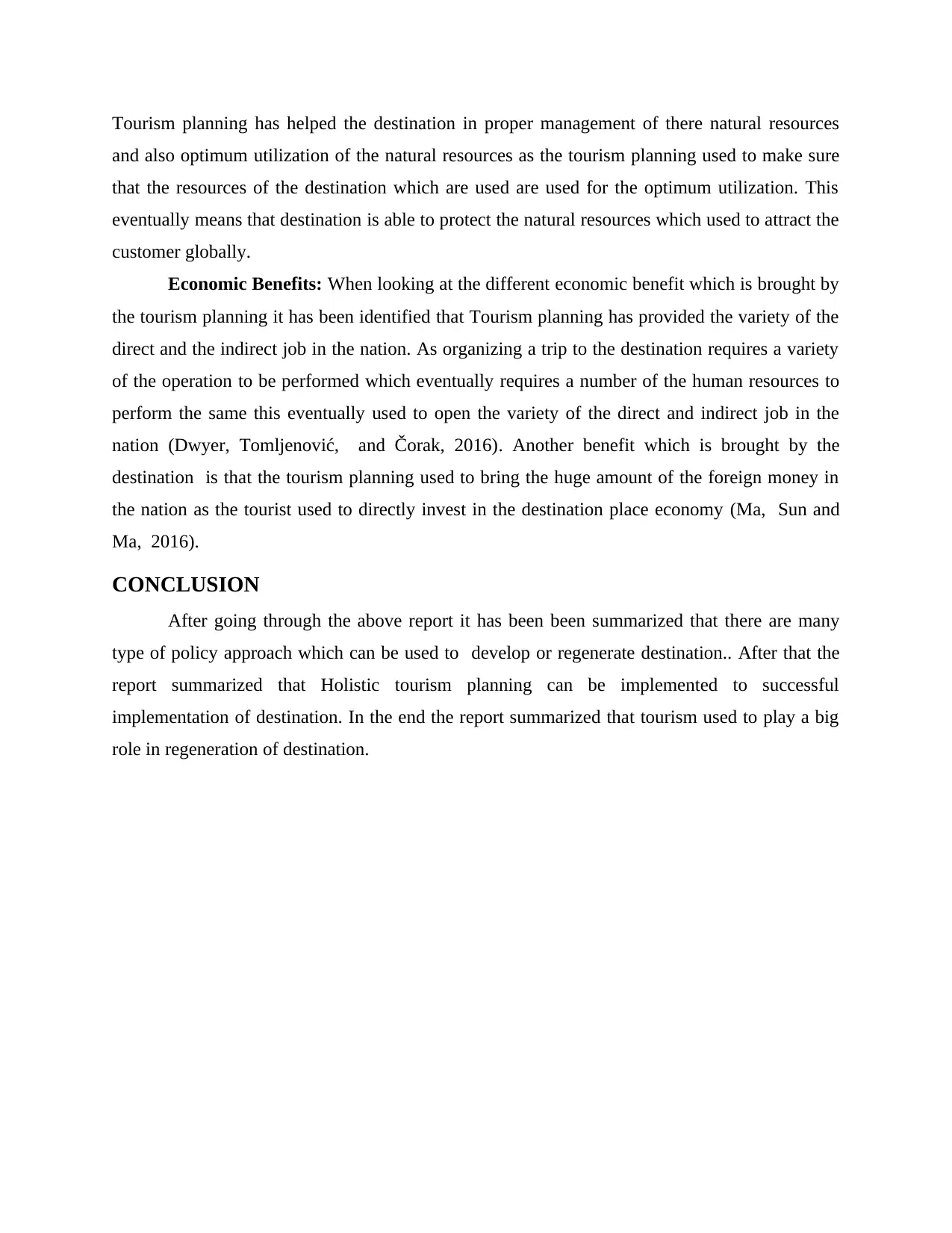
Tourism planning has helped the destination in proper management of there natural resources
and also optimum utilization of the natural resources as the tourism planning used to make sure
that the resources of the destination which are used are used for the optimum utilization. This
eventually means that destination is able to protect the natural resources which used to attract the
customer globally.
Economic Benefits: When looking at the different economic benefit which is brought by
the tourism planning it has been identified that Tourism planning has provided the variety of the
direct and the indirect job in the nation. As organizing a trip to the destination requires a variety
of the operation to be performed which eventually requires a number of the human resources to
perform the same this eventually used to open the variety of the direct and indirect job in the
nation (Dwyer, Tomljenović, and Čorak, 2016). Another benefit which is brought by the
destination is that the tourism planning used to bring the huge amount of the foreign money in
the nation as the tourist used to directly invest in the destination place economy (Ma, Sun and
Ma, 2016).
CONCLUSION
After going through the above report it has been been summarized that there are many
type of policy approach which can be used to develop or regenerate destination.. After that the
report summarized that Holistic tourism planning can be implemented to successful
implementation of destination. In the end the report summarized that tourism used to play a big
role in regeneration of destination.
and also optimum utilization of the natural resources as the tourism planning used to make sure
that the resources of the destination which are used are used for the optimum utilization. This
eventually means that destination is able to protect the natural resources which used to attract the
customer globally.
Economic Benefits: When looking at the different economic benefit which is brought by
the tourism planning it has been identified that Tourism planning has provided the variety of the
direct and the indirect job in the nation. As organizing a trip to the destination requires a variety
of the operation to be performed which eventually requires a number of the human resources to
perform the same this eventually used to open the variety of the direct and indirect job in the
nation (Dwyer, Tomljenović, and Čorak, 2016). Another benefit which is brought by the
destination is that the tourism planning used to bring the huge amount of the foreign money in
the nation as the tourist used to directly invest in the destination place economy (Ma, Sun and
Ma, 2016).
CONCLUSION
After going through the above report it has been been summarized that there are many
type of policy approach which can be used to develop or regenerate destination.. After that the
report summarized that Holistic tourism planning can be implemented to successful
implementation of destination. In the end the report summarized that tourism used to play a big
role in regeneration of destination.
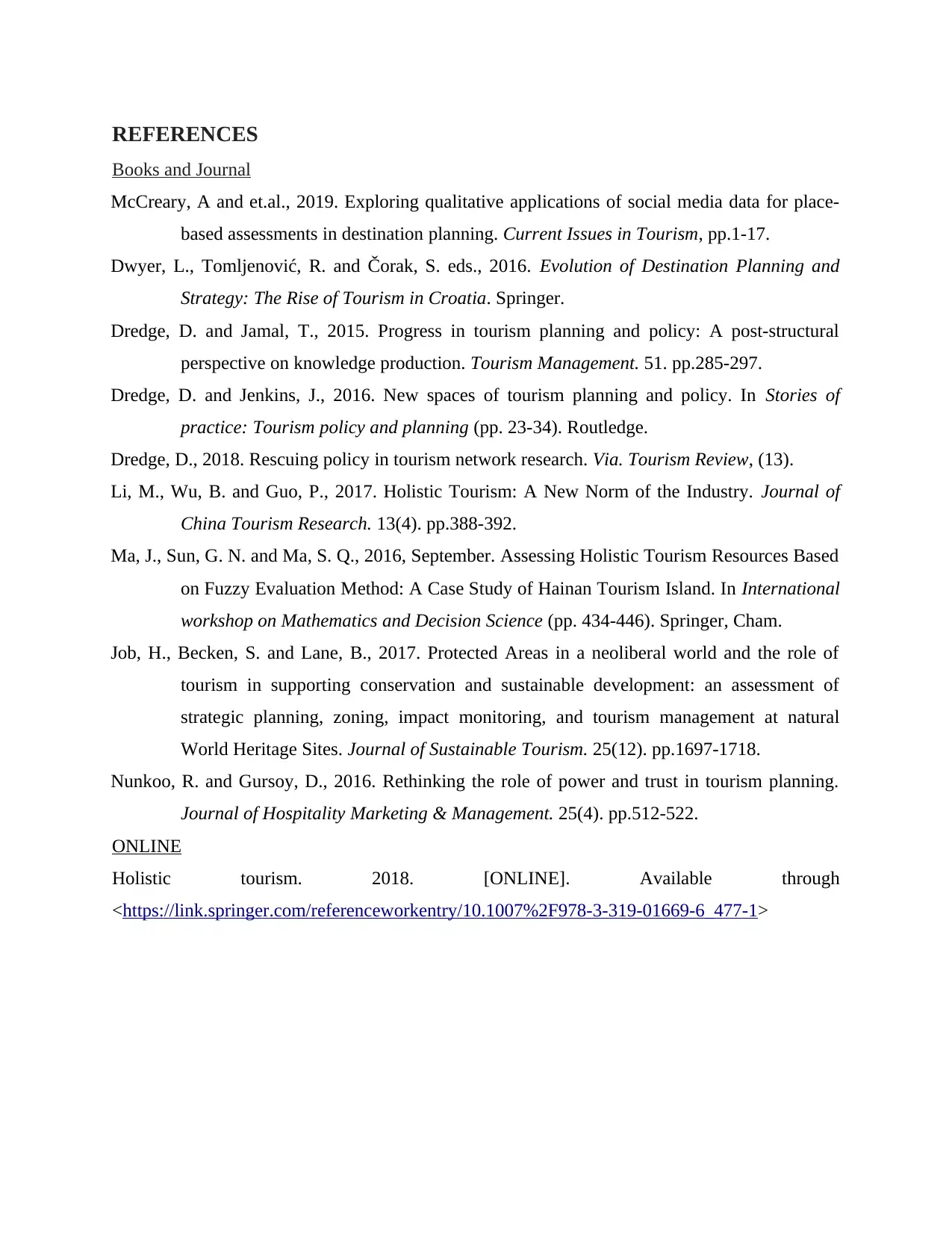
REFERENCES
Books and Journal
McCreary, A and et.al., 2019. Exploring qualitative applications of social media data for place-
based assessments in destination planning. Current Issues in Tourism, pp.1-17.
Dwyer, L., Tomljenović, R. and Čorak, S. eds., 2016. Evolution of Destination Planning and
Strategy: The Rise of Tourism in Croatia. Springer.
Dredge, D. and Jamal, T., 2015. Progress in tourism planning and policy: A post-structural
perspective on knowledge production. Tourism Management. 51. pp.285-297.
Dredge, D. and Jenkins, J., 2016. New spaces of tourism planning and policy. In Stories of
practice: Tourism policy and planning (pp. 23-34). Routledge.
Dredge, D., 2018. Rescuing policy in tourism network research. Via. Tourism Review, (13).
Li, M., Wu, B. and Guo, P., 2017. Holistic Tourism: A New Norm of the Industry. Journal of
China Tourism Research. 13(4). pp.388-392.
Ma, J., Sun, G. N. and Ma, S. Q., 2016, September. Assessing Holistic Tourism Resources Based
on Fuzzy Evaluation Method: A Case Study of Hainan Tourism Island. In International
workshop on Mathematics and Decision Science (pp. 434-446). Springer, Cham.
Job, H., Becken, S. and Lane, B., 2017. Protected Areas in a neoliberal world and the role of
tourism in supporting conservation and sustainable development: an assessment of
strategic planning, zoning, impact monitoring, and tourism management at natural
World Heritage Sites. Journal of Sustainable Tourism. 25(12). pp.1697-1718.
Nunkoo, R. and Gursoy, D., 2016. Rethinking the role of power and trust in tourism planning.
Journal of Hospitality Marketing & Management. 25(4). pp.512-522.
ONLINE
Holistic tourism. 2018. [ONLINE]. Available through
<https://link.springer.com/referenceworkentry/10.1007%2F978-3-319-01669-6_477-1>
Books and Journal
McCreary, A and et.al., 2019. Exploring qualitative applications of social media data for place-
based assessments in destination planning. Current Issues in Tourism, pp.1-17.
Dwyer, L., Tomljenović, R. and Čorak, S. eds., 2016. Evolution of Destination Planning and
Strategy: The Rise of Tourism in Croatia. Springer.
Dredge, D. and Jamal, T., 2015. Progress in tourism planning and policy: A post-structural
perspective on knowledge production. Tourism Management. 51. pp.285-297.
Dredge, D. and Jenkins, J., 2016. New spaces of tourism planning and policy. In Stories of
practice: Tourism policy and planning (pp. 23-34). Routledge.
Dredge, D., 2018. Rescuing policy in tourism network research. Via. Tourism Review, (13).
Li, M., Wu, B. and Guo, P., 2017. Holistic Tourism: A New Norm of the Industry. Journal of
China Tourism Research. 13(4). pp.388-392.
Ma, J., Sun, G. N. and Ma, S. Q., 2016, September. Assessing Holistic Tourism Resources Based
on Fuzzy Evaluation Method: A Case Study of Hainan Tourism Island. In International
workshop on Mathematics and Decision Science (pp. 434-446). Springer, Cham.
Job, H., Becken, S. and Lane, B., 2017. Protected Areas in a neoliberal world and the role of
tourism in supporting conservation and sustainable development: an assessment of
strategic planning, zoning, impact monitoring, and tourism management at natural
World Heritage Sites. Journal of Sustainable Tourism. 25(12). pp.1697-1718.
Nunkoo, R. and Gursoy, D., 2016. Rethinking the role of power and trust in tourism planning.
Journal of Hospitality Marketing & Management. 25(4). pp.512-522.
ONLINE
Holistic tourism. 2018. [ONLINE]. Available through
<https://link.springer.com/referenceworkentry/10.1007%2F978-3-319-01669-6_477-1>
⊘ This is a preview!⊘
Do you want full access?
Subscribe today to unlock all pages.

Trusted by 1+ million students worldwide

Paraphrase This Document
Need a fresh take? Get an instant paraphrase of this document with our AI Paraphraser


⊘ This is a preview!⊘
Do you want full access?
Subscribe today to unlock all pages.

Trusted by 1+ million students worldwide
1 out of 12
Related Documents
Your All-in-One AI-Powered Toolkit for Academic Success.
+13062052269
info@desklib.com
Available 24*7 on WhatsApp / Email
![[object Object]](/_next/static/media/star-bottom.7253800d.svg)
Unlock your academic potential
Copyright © 2020–2025 A2Z Services. All Rights Reserved. Developed and managed by ZUCOL.





